Python turtle.setup() truncates canvas to screen size - how to avoid that?
To measure the rotation speed of a rod, I need to make a dial with a large number of alternating dark / transparent segments arranged in a circle. The rotating dial will interrupt the light on a photosensor, and then I only need to measure the frequency of light pulses. Python turtle graphics seems like a good idea for drawing this dial.
I need to draw this image very large, so as to avoid the stair-step effect on the edges of the segments - I need smooth edges. But if I do turtle.setup(x, y) with either x or y bigger than the screen, the canvas is truncated to fit the screen. How to avoid that?
My code is included at the end. See here a screenshot with the truncated canvas for x = y = 1420

EDIT: Just to make it clear - getscreen() / getcanvas() at the end capture this truncated canvas image and save it as-is (truncated) into an EPS file. That's what bothers me. I need the whole circle captured in a high-resolution image file.
I am using python-2.7.4 on Ubuntu 13.04
This is the code:
#!/usr/bin/python
# set this to 1 to troubleshoot
debug = 0
import turtle
import math
# image file with the result
fname="dial.eps"
# number of lines
n = 100
# external radius
r2 = 700
# length of each line
l = round(r2 / 10)
r1 = r2 - l
# pen thickness
# tuned for 50% fill factor at the inner end of each line
# (dark stripe and transparent stripe have equal width there)
thick = 2 * math.pi * r1 / float(2 * n)
print "thickness =", thick
# setup screen size to contain the whole circle, plus a little extra
border = 20 + thick
turtle.setup(2 * r2 + border, 2 * r2 + border)
dot = turtle.Turtle()
dot.speed(0)
dot.hideturtle()
# draw crosshairs in the center
dot.setpos(l, 0)
dot.setpos(-l, 0)
dot.home()
dot.setpos(0, l)
dot.setpos(0, -l)
dot.penup()
# thickness of lines
dot.pensize(thick)
for step in range(0, n):
a = 360.0 * step / float(n)
arad = math.radians(a)
x1 = r1 * math.cos(arad)
y1 = r1 * math.sin(arad)
x2 = r2 * math.cos(arad)
y2 = r2 * math.sin(arad)
if debug == 1:
print "a =", a, "\t x1 =", x1, "\t y1 =", y1, "\t x2 =", x2, "\t y2 =", y2
dot.penup()
dot.setpos(x1, y1)
dot.pendown()
dot.setpos(x2, y2)
ts = turtle.getscreen()
ts.getcanvas().postscript(file=fname)
print "Saved image to: ", fname
print "All done. Click image to exit."
turtle.exitonclick()
Answer
- You can't set the turtle canvas bigger than your screen
- The EPS file saved by
getcanvas().postscriptis resolution-independent; you can print it at any size and it will still come out at your printer's native resolution.
I modified your code to read the screen size and change the circle radius accordingly:
#!/usr/bin/python
# set this to 1 to troubleshoot
debug = 0
import turtle
import math
ts = turtle.getscreen()
max_size = 0
if ts.window_width > ts.window_height:
max_size = ts.window_height()
else:
max_size = ts.window_width()
# image file with the result
fname = 'dial.eps'
# number of lines
n = 100
# external radius
# r2 = 700
r2 = 0.8 * max_size / 2
# length of each line - changed from 'l', which looks too much like 1
line_length = round(r2 / 10)
r1 = r2 - line_length
# pen thickness
# tuned for 50% fill factor at the inner end of each line
# (dark stripe and transparent stripe have equal width there)
thick = 2 * math.pi * r1 / float(2 * n)
print 'thickness =', thick
# setup screen size to contain the whole circle, plus a little extra
border = 20 + thick
# turtle.setup(2 * r2 + border, 2 * r2 + border)
dot = turtle.Turtle()
dot.speed(0)
dot.hideturtle()
# draw crosshairs in the center
dot.setpos(line_length, 0)
dot.setpos(-line_length, 0)
dot.home()
dot.setpos(0, line_length)
dot.setpos(0, -line_length)
dot.penup()
# thickness of lines
dot.pensize(thick)
for step in range(0, n):
a = 360.0 * step / float(n)
arad = math.radians(a)
x1 = r1 * math.cos(arad)
y1 = r1 * math.sin(arad)
x2 = r2 * math.cos(arad)
y2 = r2 * math.sin(arad)
if debug == 1:
print 'a =', a, '\t x1 =', x1, '\t y1 =', y1, '\t x2 =', x2, \
'\t y2 =', y2
dot.penup()
dot.setpos(x1, y1)
dot.pendown()
dot.setpos(x2, y2)
ts.getcanvas().postscript(file=fname)
print 'Saved image to: ', fname
print 'All done. Click image to exit.'
turtle.exitonclick()
Zoomed in at 500%, there are no jaggies:

Oh, and please never use l as a variable name; it looks too much like 1. Bad programmer, no biscuit … ☺